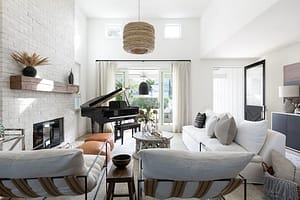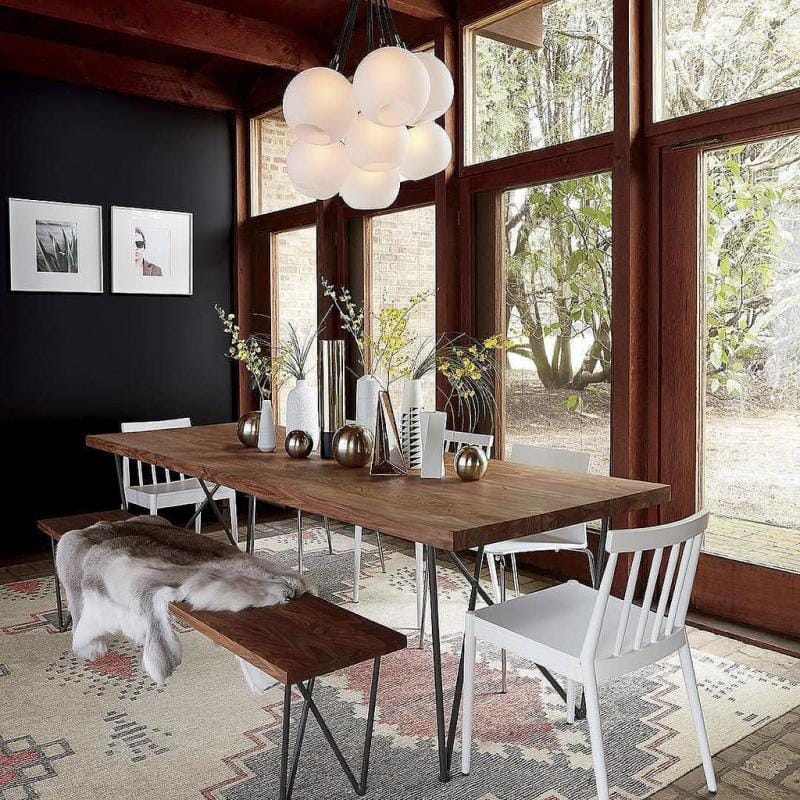
If you are considering painting a room in your home, here’s why you shouldn’t use dark paint colors. While it’s true that bold, dark shades are currently trending, and can create beautiful, elegant, and dramatic spaces, it’s important to be aware of some potential drawbacks before diving in.
Deeper hues, while cozy and warm, can also make a room feel smaller, darker, and even a bit depressing. They can also fade faster in sunlight, highlight imperfections on the walls, and require multiple coats of paint to cover up if you change your mind.
However, don’t let the cons scare you away entirely! Painting a room is a relatively low-risk way to experiment with your decor, and it’s always easy to change if you’re not happy. After reading this post, “Why You Shouldn’t Use Dark Paint Colors,” follow the tips below to avoid common mistakes and ensure your dark-painted room is a success.
The Underlying Psychology of Dark Paint Colors

Here’s why you shouldn’t use dark paint colors, it’s not just about aesthetics, but also about the psychological effect these colors have on us. Colors significantly influence our emotional responses and overall mood. Dark colors, in particular, are known for their intense psychological impact.
“While dark colors can be incredibly cozy and dramatic, they can also shrink a space and make it feel heavy. In smaller rooms or rooms with limited natural light, lighter colors tend to open things up and create a more airy feel.”
Joanna Gaines, designer and television personality
“If you are looking for a way to style your space with wall art without breaking your piggy bank, then I recommend reading “10 Surprising Benefits of Printable Wall Art”
Impact of Dark Colors on Mood and Perception
Dark hues, such as deep blues, rich purples, or intense blacks, tend to evoke feelings of melancholy or sadness. They can create an atmosphere of heaviness or even oppression, far from the relaxing and soothing environment you would want for your home. The psychological impact of dark colors is substantial enough to affect your daily mood and overall well-being, which is a crucial factor to consider when choosing your interior paint colors.
Also: The 12-12-12 Decluttering Method: Your Roadmap to a Clutter-Free Haven
The profound psychological effects of dark paint colors could be one of the reasons why interior design experts often advise against their use, especially in spaces where you spend significant time. It’s essential to strike a balance between aesthetics and the emotional well-being of the inhabitants, and often, lighter colors tend to be a safer bet.
The Practical Challenges with Dark Paint Colors

As beautiful as dark paint colors may appear at first glance, they come with a unique set of maintenance and space perception challenges that can significantly affect your day-to-day living experience.
Maintenance Dilemmas with Dark Paint Colors
One of the most significant practical difficulties with dark paint colors is their high maintenance. Dark hues, especially in high-traffic areas of your home, are notorious for showing dust, smudges, and scratches more prominently than lighter colors. This means you may find yourself cleaning your walls more frequently, adding to your list of household chores and creating potential inconvenience.
Space Perception with Dark Paint Colors
Additionally, another reason why you shouldn’t use dark paint colors is their impact on space perception. Dark colors tend to absorb light, making a room appear smaller and more confined. This can be a major drawback if you’re working with a limited space, as it can make the room feel cramped and uncomfortable. A lighter color palette, on the other hand, can create an illusion of spaciousness, making your room feel larger and more welcoming.
Also: How To Design A Nursery: A Step-by-Step Guide for First-Time Moms
The Aesthetic Limitations of Dark Paint Colors

While it may be tempting to embrace the allure of dark paint colors, it is important to understand the aesthetic limitations they impose on your interior design. This section explores the challenges and potential drawbacks that can arise when using dark hues in your living spaces.
“Dark paint colors can be tricky because they hide architectural details and artwork. If you have beautiful molding, trim, or statement pieces, using a lighter color allows them to stand out and become focal points in the room.”
Nate Berkus, Decorator and television personality
Decorative Complications with Dark Paint Colors
Dark paint colors can present decorative challenges, especially when it comes to achieving balance and harmony in your space. The strong visual presence of dark walls can overpower furniture and décor, causing them to appear washed out or insignificant. Achieving a cohesive and visually pleasing design becomes more difficult when the dominance of dark paint colors disrupts the overall aesthetic flow.
Selective Suitability of Dark Paint Colors
Furthermore, it is important to recognize that not all dark colors work well in every room. Each space has its own unique lighting conditions, architectural features, and size, which can greatly impact the suitability of dark paint colors. For instance, a dark color might look stunning in a large, well-lit living room, where it can add a sense of drama and sophistication. However, the same dark color might make a small bathroom feel cramped and unwelcoming, diminishing its functionality and appeal.
Considering these aesthetic limitations, it becomes evident that dark paint colors require careful consideration and planning. It is essential to assess the specific characteristics of your space and to consider alternative options that can provide a more versatile and visually pleasing outcome.
Also: How to Design a Man Cave That Rocks
Exploring Alternatives to Dark Paint Colors

Given the potential challenges and limitations associated with dark paint colors, it is worthwhile to explore alternative options that can achieve a similar desired effect without the drawbacks. By considering lighter hues and alternative approaches, you can create a visually appealing and inviting space that meets your design goals.
The Appeal of Lighter Hues
Instead of automatically resorting to dark paint colors, consider the appeal of lighter hues. Lighter colors have the ability to enhance the ambiance of a room, making it feel open, spacious, and inviting. Pastel shades, soft neutrals, or warm whites can create a soothing and serene atmosphere, providing a versatile backdrop for various decor styles and allowing your furniture and accessories to shine.
“Dark paint colors can be beautiful, but they do require careful consideration. If you’re set on using them, make sure to balance them with plenty of light-colored furniture and accessories to avoid the space feeling cave-like.”
Justina Blakeney, designer and author
Success Story: From Dark to Light

A real-life example showcasing the transformation from dark to light can provide insight into the impact lighter hues can have on a space. Imagine a living room originally painted in a deep navy blue, which created a sense of enclosure and gloominess. By transitioning to a soft beige paint, the room underwent a remarkable change. The lighter color made the space appear larger, brighter, and more inviting. The furniture and decor pieces stood out against the light background, creating a harmonious and aesthetically pleasing environment.
Also: How To Decorate a Desk at Home
By considering the success story mentioned above, it becomes evident that opting for lighter paint colors can have a significant impact on the overall atmosphere and visual appeal of a room.
So, instead of automatically reaching for dark paint colors, it is essential to weigh the potential challenges and limitations they may bring. By exploring alternatives, such as lighter hues, you can create a space that not only reflects your personal style but also promotes a sense of openness, harmony, and visual balance.
Most Popular Post:
10 Surprising Benefits of Printable Wall Art
How to Choose The Right TV Size to Decorate Your Living Room
The ultimate Smart Home Design Guide: Automate your life
Tips for Home Decorating on a Budget: Where to Splurge and Save
10 Best Couch Colors That Make a Room Look Bigger
Conclusion
Here’s why you shouldn’t use dark paint colors without careful consideration. While they may initially seem appealing for their elegance and drama, dark paint colors come with a set of challenges that can affect both the psychological and practical aspects of your living space.
Psychologically, dark colors can evoke feelings of melancholy and heaviness, impacting your mood and overall well-being. Practically, dark paint colors require higher maintenance due to their tendency to show dust and scratches more prominently. They can also make a room appear smaller and more confined, limiting the sense of spaciousness and comfort.
Aesthetically, dark paint colors can present challenges in achieving balance and harmony in your interior design. They can overpower furniture and décor, disrupting the visual flow. Additionally, not all dark colors work well in every room, and the specific characteristics of your space need to be considered.
Exploring alternatives, such as lighter hues, can provide a solution. Lighter colors have the ability to enhance the ambiance of a room, making it feel open, spacious, and inviting. They offer versatility, allowing your furniture and accessories to shine and creating a visually pleasing environment.
While dark paint colors may hold allure, it is important to carefully evaluate their impact before making a decision. By considering the psychological, practical, and aesthetic aspects, and exploring alternative options, you can create a living space that promotes a positive mood, requires less maintenance, and achieves a visually harmonious and inviting atmosphere.
Why You Shouldn’t Use Dark Paint Colors (FAQs)
Q1: Why should I be cautious when using dark paint colors for my interior?
While dark paint colors can add elegance and drama to a space, they come with certain considerations. Dark colors can impact the mood in a room, require higher maintenance, and make a space appear smaller and confined.
Q2: Are there any practical challenges associated with dark paint colors?
Yes, dark paint colors can be more prone to showing dust and scratches, requiring more frequent cleaning and touch-ups compared to lighter hues.
Q3: Can dark paint colors affect the aesthetics of a room?
Dark paint colors can present challenges in achieving balance and harmony in your interior design. They can overpower furniture and décor, disrupting the visual flow and making it difficult to create a cohesive design.
Q4: Are there any alternatives to dark paint colors?
Yes, lighter hues can be a great alternative to dark paint colors. Lighter colors can enhance the ambiance of a room, making it feel open, spacious, and inviting. They offer versatility and allow other elements in the room to shine.
Q5: How can I decide if dark paint colors are suitable for my space?
Consider the specific characteristics of your space, including lighting conditions, architectural features, and size. Assess how a dark color would interact with these factors and consider alternative options if necessary.
Q6: Can you provide an example of a successful transformation from dark to light paint colors?
Certainly! Imagine a living room originally painted in a deep navy blue. By transitioning to a soft beige paint, the room underwent a remarkable change, appearing larger, brighter, and more inviting. The lighter color allowed the furniture and decor pieces to stand out, creating a harmonious and aesthetically pleasing environment.
Q7: How can I make my living space visually appealing without using dark paint colors?
Opt for lighter hues like pastel shades, soft neutrals, or warm whites. These colors can create a soothing and serene atmosphere, serving as a versatile backdrop for various decor styles and allowing your furniture and accessories to shine.
Q8: Are there any advantages to having an FAQ page?
Absolutely! FAQ pages provide a self-service portal for users to find answers to common questions, reducing the load on customer support teams. They also improve website navigation, organic traffic, and overall user experience by providing valuable information and solutions.
Q9: How should I structure my FAQ page?
Structure your FAQ page by categorizing questions based on specific topics. Consider using an accordion or collapsible sections to avoid overwhelming users with long pages.
Q10: How can I make my FAQ page effective?
To create an effective FAQ page, keep answers concise, use categories or topics for organization, provide links to related resources, maintain your brand’s voice and tone, and track user interactions to improve the page over time.
IN CASE YOU MISSED IT:

Complete Guide To a Perfect Bachelor Pad

4 Rectangle Living Room Layout Ideas

Best Home Decor Ideas On a Budget
CATCH THE LATEST IN HOME DECOR TRENDS:
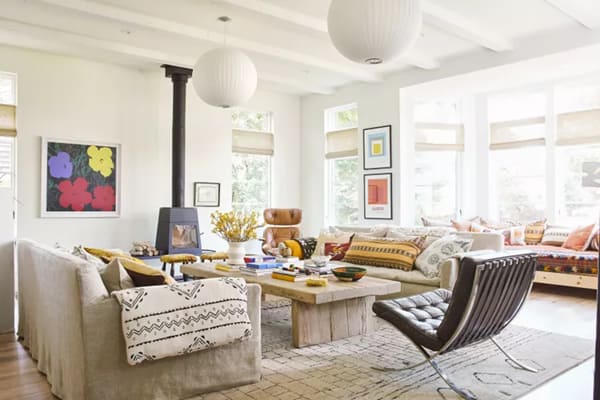
Steal These 15 Expert-Approved Decorating Secrets
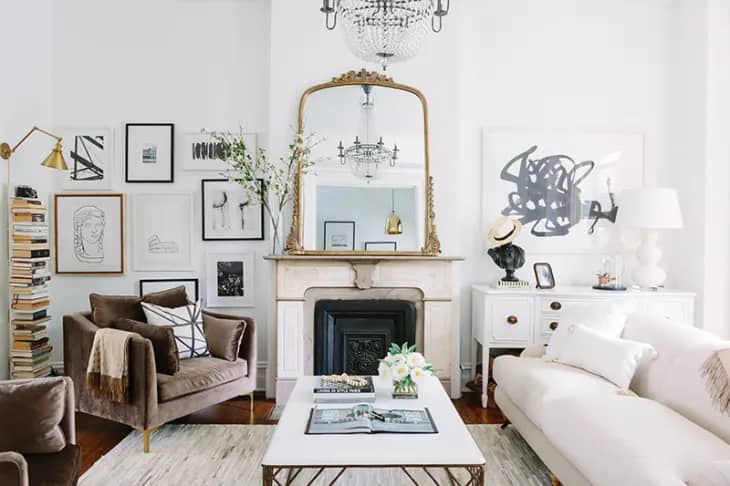
How To Accessories Your Living Room
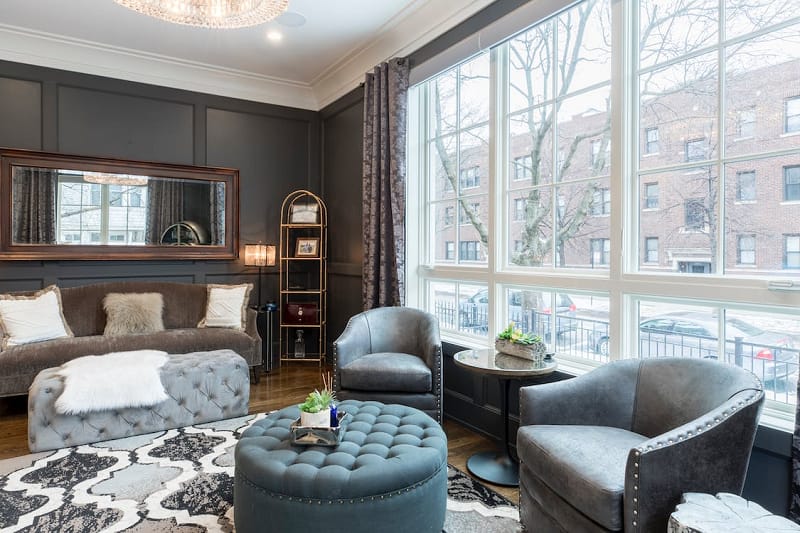
Small Space? 10 Ways To Make A Room Appear Bigger
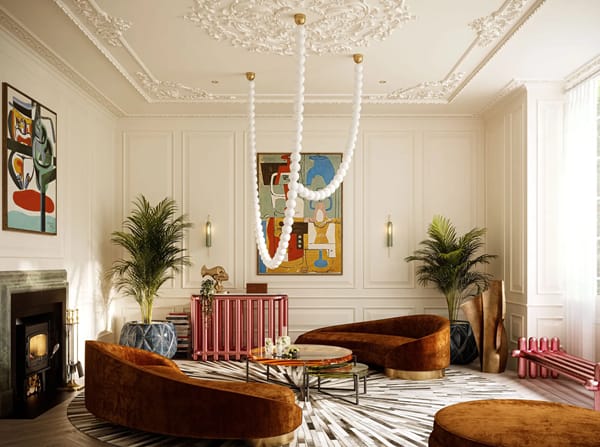
Make Your space Look Expensive
GET CAUGHT UP ON ALL THE INSPIRING DECOR TIPS:
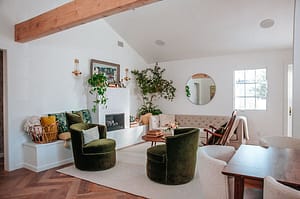
18 Fresh Decorating Ideas To Update Your Fireplace
Are you yearning for a fireplace that not only warms your space but also wows your guests? Look no further! ...

How To Create An Art Gallery Wall
Have you ever walked into a room and felt like something was missing? Maybe it needs a splash of personality, ...

How To Decorate a Living Room With White Walls
Don't make your all-white space boring, here are some great tips on how to decorate a living room with white ...

18 Fresh Decorating Ideas To Update Your Fireplace

How To Create An Art Gallery Wall
